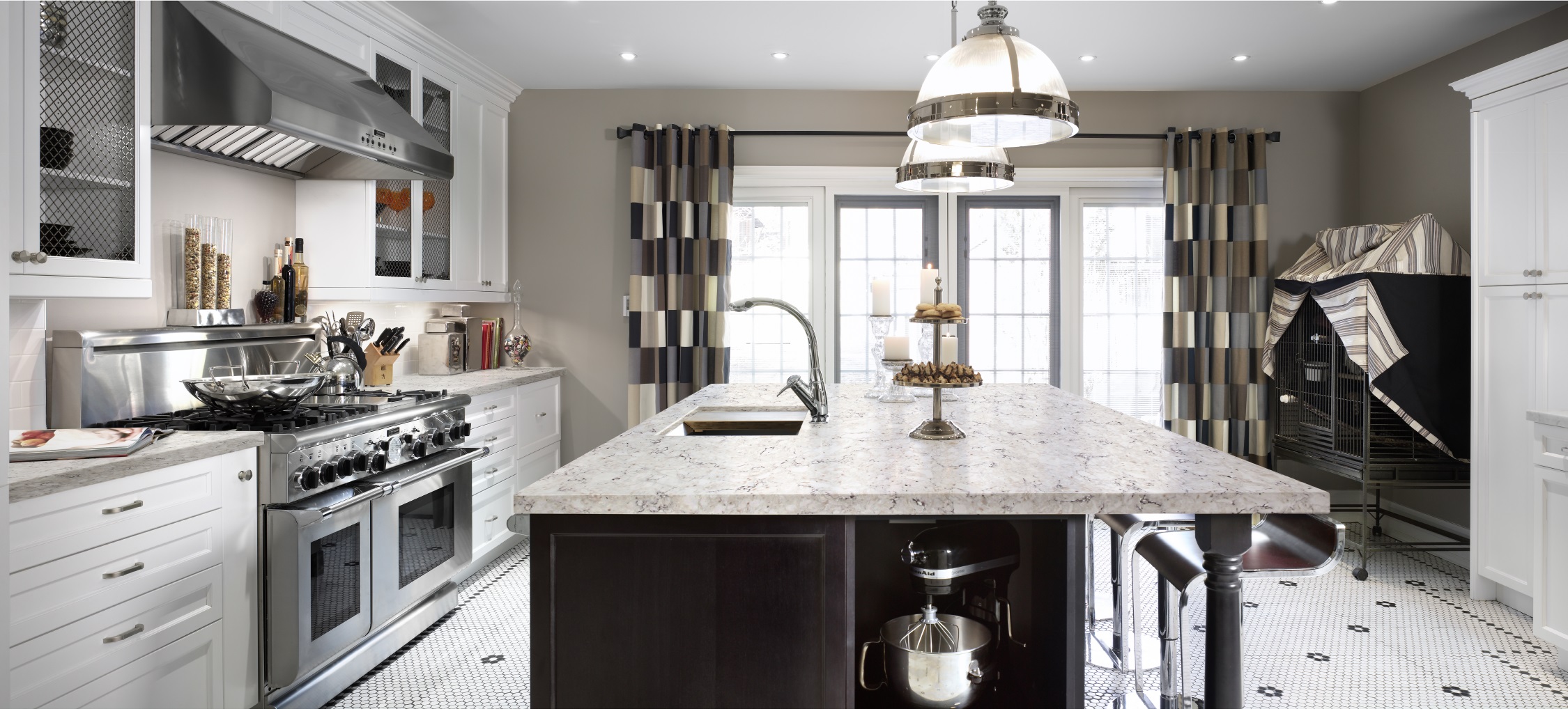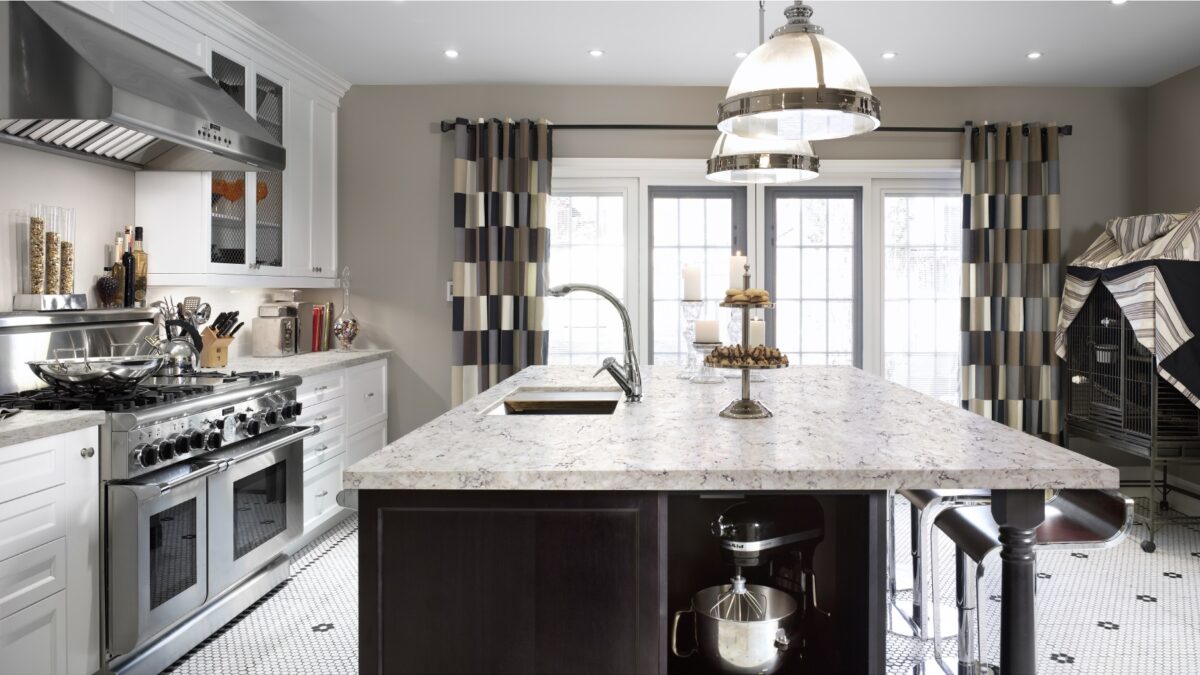Quartz is among the most coveted materials for vanity tops, boasting numerous advantages over other countertop options. Renowned for its strength, non-porous nature, and vast selection of colors and designs, quartz stands out as a superior choice for bathrooms. Its resilience against standing water, moisture, and frequent usage makes it particularly well-suited for areas prone to wear and tear.
In this article, we’ll delve into the reasons quartz is an optimal choice for vanity tops and explore why it should be a key consideration in your next renovation project.
What Is Calacatta Quartz?
Quartz, an engineered countertop material, is crafted from natural quartz stones blended with resins, polymers, and pigments, resulting in an ultra-durable slab. This manufacturing process not only ensures quartz’s superior durability but also preserves the natural allure of stone. In the following sections, we will explore the specific advantages of choosing quartz.

- Non-porous
Quartz countertops are inherently non-porous, which provides several key benefits. Since they don’t absorb liquids, quartz surfaces are impervious to warping or staining, even when exposed to water, moisture, or humidity—conditions that are commonplace in a bathroom setting.
Furthermore, the non-porous nature of quartz makes it naturally resistant to the growth of viruses and bacteria. This means that when you use a quartz countertop to store personal hygiene items such as toothbrushes and face wash, you can be confident that your vanity is not fostering any unwanted bacterial cultures.
- Durability & Maintenance
One of the significant benefits of engineered quartz is that it never requires sealing. Unlike natural stones such as granite and marble, quartz maintains its resistance to water damage, stains, and scuffs without any additional maintenance. Cleaning is also remarkably straightforward—simply wiping down your vanity with soap and water will keep it looking pristine.
Despite its numerous advantages, quartz does have a few limitations in terms of durability. The material can be susceptible to heat damage because the resins and polymers within quartz are not heat-resistant. Placing hot tools, like curling irons, directly on the countertop can result in permanent discoloration. Additionally, prolonged exposure to sunlight may cause the countertop to yellow over time. Therefore, it is advisable to avoid installing quartz in areas directly adjacent to windows to prevent such issues.
- Appearance and Style
Quartz is highly valued for its aesthetic appeal, offering a broad spectrum of colors that range from crisp whites to elegant grays and warm creams. Its potential for striking veining gives it an appearance similar to that of marble slabs, providing a touch of luxury. Additionally, some quartz varieties include mirrored chip pieces within their composition, lending sparkle and brightness to any room. With such versatility, quartz effortlessly complements virtually any design style, making it a versatile choice for enhancing the beauty of a space.
What are the considerations when you choose a quartz vanity top?
When determining if a quartz countertop is the ideal choice for your bathroom, several factors should be taken into account. Assess whether the cost fits within your budget, identify your visual design preferences, and decide on the desired thickness for your slab. These considerations will guide you in making an informed decision that aligns with your needs and aesthetic aspirations.
- Cost
Quartz countertops represent an excellent middle-ground in terms of the cost of countertop materials. Typically, you’ll find them priced between $50 and $150 per square foot, positioning them as a more affordable option than granite and marble, yet pricier than butcher block, laminate, or vinyl.
The composition of the quartz countertop significantly influences its cost. Slabs that contain a lower quartz content — about 88 percent — tend to be of lower quality and, consequently, less expensive. On the other hand, slabs with a higher quartz content, around 93 percent, command a higher price. Additionally, opting for custom features like sink cut-outs or specialized edge treatments can further elevate the overall cost of your project.
- Design
The extensive color palette offered by quartz ensures that you can find a vanity top that perfectly aligns with your bathroom’s color scheme and design aesthetic. For instance, a solid pink slab can beautifully complement the vintage tiles of a 1950s bathroom. Alternatively, for a more modern look, a white quartz slab with bold veining can be installed to transform your countertop into a standout feature. Thanks to contemporary manufacturing techniques, quartz can mimic the appearance of natural stone while eliminating the higher costs and maintenance requirements associated with it.
- Thickness
The standard thickness for a quartz countertop is 3 cm, providing a tested and reliable level of strength capable of supporting regular use without the risk of breakage or chipping. This thickness also ensures that there is no need for an additional base to stabilize the countertop, maintaining its structural integrity. While thicker countertops exceeding 3 cm are an option, it is important to consider that these heavier countertops might lead to extra wear and tear on your floors, particularly in older homes.

